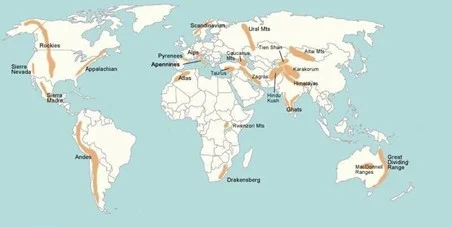Answer:
| Approach:
Introduction
- Briefly define the mountain ranges and its Characteristics
Body
- Mention some mountain ranges of the word and its Climate Influence on local weather and climate.
Conclusion
- Conclude your Answer with the importance of the mountain ranges.
|
Introduction:
The major mountain ranges of the world are aligned along tectonic plate boundaries, where the movement of the Earth’s crust has resulted in the formation of large mountainous regions. The alignment of these mountain ranges can have a significant impact on local weather conditions, influencing temperature, precipitation, and wind patterns.

Body:
Mountain Ranges and its Climatic Influence. There are several important mountain ranges around the world that have significant climate influences on local weather and climate. Here are some examples:
The Himalayas:
- It is located in Asia, the highest mountain range in the world.
- The Himalayas act as a barrier, preventing the movement of cold air from the north. Protect from harsh winters.
- Influence the monsoon winds that bring rainfall to India and other surrounding countries.
The Andes:
- It is located in South America, the longest mountain range in the world.
- The Andes act as a barrier, preventing the movement of moisture from the east and influencing the precipitation patterns in the region.
- It acts as a rain shadow zone for Atacama deserts.
- The Andes have an impact on the temperature and rainfall patterns in neighboring countries such as Argentina, Chile, and Peru.
The Rocky Mountains:
- It is located in North America.
- The Rockies influence the movement of air masses, causing them to rise and cool, leading to increased precipitation on the western slopes and a rain shadow effect on the eastern slopes.
- They capture the moisturized winds from the Pacific and cause large amount of rainfall in its windward side,
- They also give a rain-shadow effect to the deserts in Southwest North America.
The Alps:
- The Alps, located in Europe.
- It acts as a barrier, preventing the movement of cold air from the north and influencing the precipitation patterns in the region.
- The Alps have a significant impact on the temperature and rainfall patterns in neighboring countries such as France, Switzerland, and Italy.
- Alps influence the presence and direction of local winds like Foehn, Mistral etc.
Conclusion:
Mountain ranges play a crucial role in shaping local weather, climate patterns, impacts on temperature, precipitation, and wind patterns, which can in turn have significant impacts on agriculture, water resources, and other aspects of local ecosystems and human societies. Therefore, understanding the impacts of mountain ranges on local weather and climate is important for managing natural resources and mitigating the impacts of climate change.
